#hokusai utamaro
Explore tagged Tumblr posts
Text
#430 「美しい春画」展 期間限定デザート!
CAFÉ CUBEでは、展覧会「美しい春画―北斎・歌麿、交歓の競艶―」に合わせ、期間限定メニューをご用意しております。

色鮮やかなルビーチョコレートをたっぷり使用した艶やかなグラサージュとムースに、抹茶を纏ったアーモンドをトッピングした贅沢なスイーツです。バニラアイスと甘酸っぱいベリーと共にお楽しみください。 「美しい春画」展の鑑賞後や、秋の岡崎散策のひとときにおすすめの華やかな一品です。カフェのみでもご利用いただけますので、是非お立寄りください。 期間:2024年11月24日(日)まで 《数量限定》 価格:ドリンクセット 1,600円(単品 1,200円) 〔セットドリンク〕 コーヒーor紅茶(カフェラテ+50円/フレーバーティー+100円)
0 notes
Photo

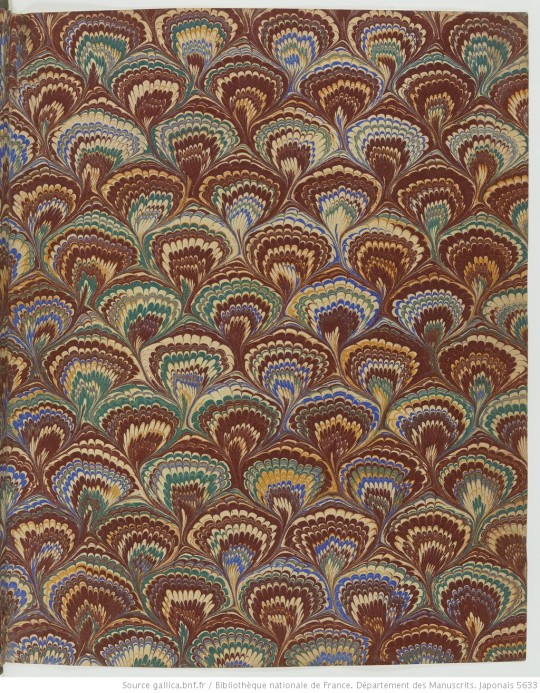
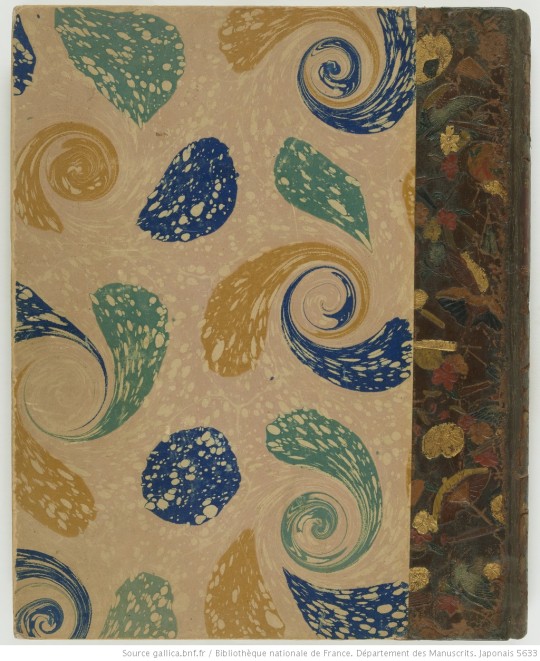
Decorative front and back covers and end paper taken from ‘Album de surimono’ after Kitagawa Utamaro, Katsushika Hokusai, Totoya Hokkei.
Published 1890-1930.
Bibliothèque nationale de France. Département des Manuscrits.
225 notes
·
View notes
Text



Società Promotrice delle Belle Arti, Torino - Utamaro, Hokusai, Hiroshige. Geishe, samurai e i miti del Giappone.
55 notes
·
View notes
Text
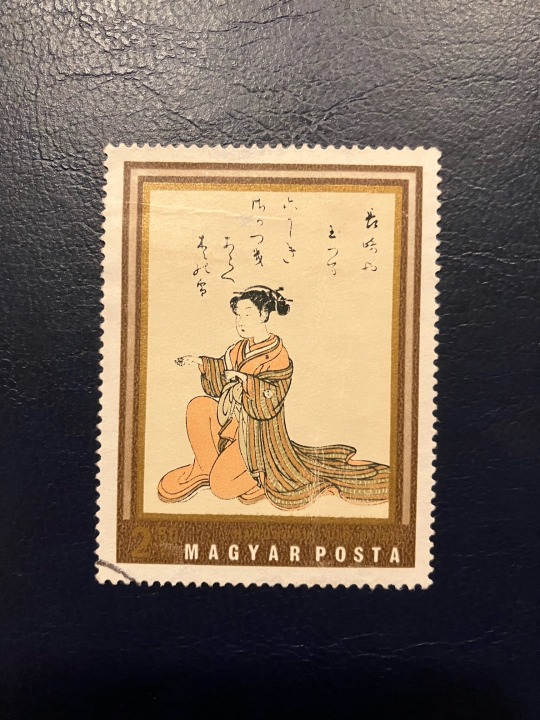
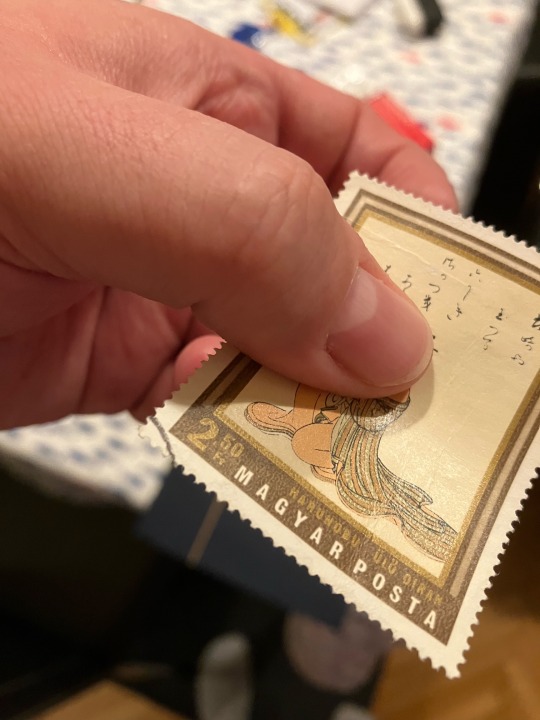
Ez az bélyeg egyik személyes kedvencem, egyrészt olyan jóóó nagy, másrészt szeretem a japán fametszeteket, harmadrészt meg meglepett a sorozat évjárata, több mint 50 éves, 1971-es! Szerintem a dizájn sokkal modernebbnek mutat, bár a 2.50 forint kicsit árulkodó. A második kép azért készült, mert úgy látszik jól a felirat, hogy kinek melyik műve látható a bélyegen.
Ezen a bélyegen Harunobu: Ülő oiran metszete látható. Suzuki Harunobu az 1700-as évek közepén élő metszetkészítő művész volt, és a műfajban hozzátartozik egy komoly reform/változtatás: az addig megszokott 2 vagy 3 színt használó metszetek helyett, ő kezdett el sokszínűeket készíteni. Ezen a művén ez épp nem látható, alighanem egy koraibb darab. Az oiranok egyébként a történelmileg magas rangú kurtizánok voltak Japánban akkoriban, az 'élvezet asszonyai'. Jellemzően képzettek voltak a hagyományos művészetek terén, és bizonyos keretekig megválogathatták vendégeiket is.
A sorozat egyébként 8 tagot számlált, 40 fillértől egész 4 forintig, különböző színű keretekkel és metszetekkel. Akinek valamelyik metszet esetleg megtetszene és utánanézne, most idemásolom az összeset:
0.40 Ft -os bélyegén Toyokuni iskola: Séta a kertben,
a 0.60 Ft -os bélyegen Eishi (1756-1829): Gésák a csónakban,
az 1,- Ft -os bélyegen Eishi (1756-1829): Képet néző nő,
az 1.50 Ft -os bélyegen Kiyonaga (1752-1815): Oiranok,
a 2,- Ft -os bélyegen Utamaro (1753-1806): Awabi halásznők,
a 2.50 Ft -os bélyegen Harunobu (1725-1770): Ülő oiran,
a 3,- Ft -os bélyegen Hokusai (1760-1849): Rőzsét vivő leány,
a 4,- Ft -os bélyegen Eishi (1756-1829): Sétáló nők és gyermekek látható.
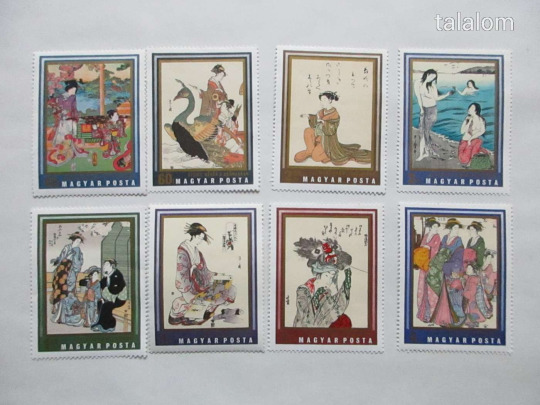
Bármilyen szép is meg menő amúgy, a teljes sorozatból 630.000-et nyomtattak, így 100-200 forint között már lehet szerezni full sorozatot. Lehet fogok is!
15 notes
·
View notes
Photo

Impressions of Ukiyo-ye, the school of the Japanese colour-print artists by Amsden
Author
Amsden, Dora, 1858-
LoC No.
50041300
Title Impressions of Ukiyo-ye, the school of the Japanese colour-print artists
Original Publication United States: Paul Elder and Company,1905.
Contents The rise of Ukiyo-ye (the floating world) -- Genroku (the golden era of romance and art) -- The school of Torii (the printers' branch of Ukiyo-ye) -- Utamaro (Le Fondateur de L'École de la Vie) -- The romance of Hokusai (master of Ukiyo-ye) -- Hiroshige (landscape painter and Apostle of Impressionism) -- Analytical comparisons between the masters of Ukiyo-ye -- Hints to collectors of Ukiyo-ye gems -- Bibliography, for use of students -- Fac-similes of the most famous signatures of the Ukiyo-ye artists.
Credits The Online Distributed Proofreading Team at
https://www.pgdp.net
(This file was produced from images generously made available by The Internet Archive)
LanguageEnglish
LoC Class
NE: Fine Arts: Print media
Subject
Color prints, Japanese
Subject
Wood-engraving -- Japan -- History
Subject
Ukiyoe -- Japan
Category Text
EBook-No.69418
Release Date Nov 24, 2022
Copyright Status Public domain in the USA.
2 notes
·
View notes
Text
Kusakabe Kimbei 日下部 金兵衛 (1841-1934)
For our first object label post, I wanted to highlight a Meji-era photographer, Kusakabe Kimbei.
A photographer primarily based in Yokohama, Kusakabe Kimbei’s work was very popular with foreign visitors and as a result can be found in many notable collections outside of Japan. He received much of his photography training in Yokohama working as a colorist and assistant under the ateliers of Felice Beato (1832-1909) and Baron Raimund von Stillfried (1839-1911) during the 1860’s and 1870’s. His studio was active from 1881 to 1914, and at its height had two locations in Yokohama and one in Tokyo.
His work poetically captures 19th century Japan and reflects and builds on Beato’s style. The high painterly quality of his oeuvre is seen in the graceful composition of the photograph below, ethereally hand-tinted and printed on albumen paper.
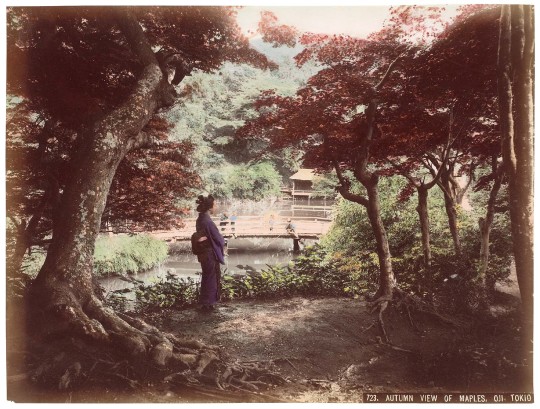
Image: Kusakabe Kimbei (日下部 金兵衛). 723. Autumn View of Maples, Oji, Tokio. c. 1895. Hand-tinted albumen print. Museum of Fine Arts, Boston.
Like many photographers in Japan of the time, his photographic compositions often make references to the world of prints - seeing as his foreign clientele would be already familiar with the print works like those of Hokusai, Hiroshige, and Utamaro.
This photograph, 723. Autumn View of Maples, Oji, Tokio, in particular references the famous autumn maple leaves in Takinogawa. This particular view seems to highlight a view from Oji Inari Shrine.
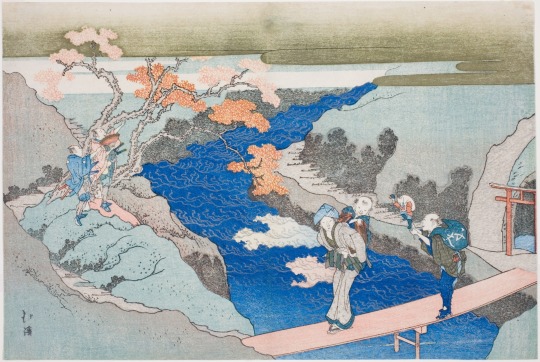
Image: Totoya Hokkei (魚屋 北渓). Autumn Maples at the Takinogawa River, ca. 1833. Color woodblock print on paper, . Brooklyn Museum.
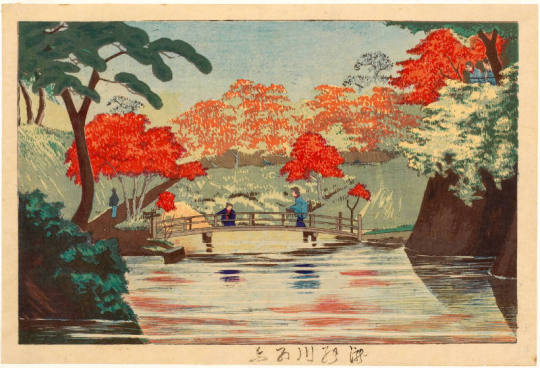
Image: Kobayashi Kiyochika (小林 清親). Takinogawa Köyö瀧の川紅葉, ca. 1880. Color woodblock print on paper, . Honolulu Museum of Art.
Further Reading:
Bennett, Terry. Early Japanese Images. Rutland: Tuttle, 1996.
Wakita, Mio. Staging Desires: Japanese Femininity in Kusakabe Kimbei’s Nineteenth Century Souvenir Photography. Berlin: Reimer, Dietrich, 2013.
Dobson, Sebastian, Anne Nishimura Morse, and Frederic Alan Sharf. Art and Artifice: Japanese Photographs of the Meiji Era. Boston, MA: Museum of Fine Arts, 2004.
Cabrejas Almena, M. Carmen. “Fotografía de ficción en Japón en el siglo XIX. Recreaciones de escenas para el mercado Occidental”. Anales de Historia del Arte 19: pg. 257-270, 2009
#art history#art#museums#objectlabel#japanese art#kusakabekimbei#asian art#woodcut#photography#japanese photography
1 note
·
View note
Text
ukiyo-e il termine (lett. «dipinti del mondo fluttuante») comprende sia le stampe su matrici in legno sia dipinti. Gli ukiyo-e conobbero grande popolarità a Edo (odierna Tōkyō) tra la fine del XVII e la metà del XIX secolo. Soggetti maggiormente ricorrenti sono i quartieri di piacere, il teatro kabuki, bellezze femminili, vedute di Edo e del Monte Fuji. Fra i principali esponenti ricordiamo Utamaro, Hokusai e Hiroshige.

Under the Wave off Kanagawa aka The Great Wave by Katsushika Hokusai, 1831
91 notes
·
View notes
Text
#427 次回展「美しい春画-北斎・歌麿、交歓の競艶-」
当館では、2016年以来 8年ぶりとなる春画をテーマとした展覧会「美しい春画-北斎・歌麿、交歓の競艶-」を、9/7(土)より開催いたします!

人間の性愛を描いた「春画」は、男女の姿がおおらかに、時にユーモアをもって描かれています。江戸時代には「笑い絵」とも呼ばれ、浮世絵の普及とともに、大名から庶民まで貴賤を問わず、男女対等に楽しまれました。 本展は、版画・版本の作品に加え、特に1点ものである「肉筆春画」に焦点をあて、これまで書籍などでその存在は知られながらも、美術館での展示が叶わなかった作品を中心にご紹介します。中でも、葛飾北斎の幻の名品「肉筆浪千鳥」は、1976年にパリで展示されて以来、長らく公開されず、日本の美術館では初の展示となります。 春画は個人の密かな楽しみというこれまでの常識を覆す喜多川歌麿の大作や、海外から里帰りを果たした作品約20件を含む、精選された美麗な春画約70件を心ゆくまでご堪能ください。
※巡回予定はありません。
「美しい春画-北斎・歌麿、交歓の競艶-」
会期:2024年 9月7日(土)~11月24日(日) [前期] 9月7日(土)~10月14日(月・祝) [後期] 10月16日(水)~11月24日(日) 休館日:毎週月曜日(祝日の場合、翌火曜日) 入館料:当日券 2,200円 前売り券 2,000円 ●お得な前売りペアチケット 2枚1組 3,800円 ※前売り券は9月6日までプレイガイドにて販売 ※18歳未満は入場禁止(会場にて年齢の分かるものをご提示いただく場合があります) ※団体・学生・障がい者などの割引はありません
主催:細見美術館、朝日新聞社、京都新聞 特別協力:角匠 協力:カルチュア・コンビニエンス・クラブ株式会社
1 note
·
View note
Text
Félix Bracquemond was twentysix years old at the time, darkly bearded, a stocky man with honest, wideset eyes. He was a complex personality: he could be arrogant, dogmatic, fiery, yet extremely charming. He was also multi -talented and became a central figure in the Parisian art scene. From his youth, when he was an assistant to a professional lithographer, he developed into a firstrate draughtsman, a talent he put to use as both a print-maker and a ceramist. While Berthe and Edma were still at school he had worked alongside Charles Méryon, a brilliant but much undervalued etcher, who was trying to resurrect this neglected art form. Bracquemond's interest in etchings grew into an ambition to exploit the market with fine prints (belles épreuves) and he was to be co-founder of the Society of Etchers. Later his career took a different direction when he became artistic director of the Haviland Porcelain Works. But at this time — the late 1850s — he lived by taking small commissions, such as the frontispieces of books. He decorated some works of the novelist Champfleury, and through him came to know a number of the pro-Realist critics and writers in Paris. At this time his friends included the Goncourt brothers, Gavarni, Alphonse Legros, Millet, Corot and Edouard Manet, as well as Fantin-Latour, who remained a close friend all his life through whom he would shortly meet Edgar Degas .Although he was a working artist, Bracquemond still found time to visit the Louvre. He shared with Fantin (who was three years his junior) a love of Delacroix, Courbet and the seventeenth-century Spanish and Dutch masters. But he was one of the first artists in France to be seduced by oriental art. From the moment in 1856 when he came across some Hokusai rejects in Delátre's bookshop in the rue Saint-Jacques, he was inspired by the fine draughtsmanship and unusual composition of Japanese prints and woodcuts. He admired the landscape design and colour of Hokusai and Hiroshige, and the realism of earlier masters like Utamaro, whose prints of everyday life were “mirrors of the passing world”. Suggestiveness, the lack of irrelevant detail, the fresh combination of colour, eve appeal — all these qualities anticipated the future direction of French art: Impressionism.
Japonisme grew in popularity after 1862 with the opening of a specialist business in the rue de Rivoli. Bracquemond, Fantin and their friends, Whistler, Manet, Degas, Stevens and James Tissot, became voluble exponents of the compositional techniques of oriental art. With certain literary critics — Baudelaire, Zacharie Astruc, Philippe Burty, Emile Zola and the Goncourts - they were patrons of the shop known paradoxically as La Porte Chinoise. Berthe caught hints of this new exotica. She learned about the artistic implications in the course of the 1860s, noting that “only Manet and the Japanese can indicate a mouth, eyes, a nose with a single stroke of the brush, so concisely that the rest of the face models itself. However, similar remarks were to be made of her work, suggesting that she too had these eclectic tendencies
1 note
·
View note
Text
The Artistic Tapestry of Ukiyo-e: Exploring Japanese Woodblock Prints
Japanese woodblock prints, also known as ukiyo-e, have captivated art enthusiasts for centuries. Originating in the 17th century, these prints reflect the unique artistic traditions of Japan and provide a window into its rich cultural heritage. This article explores the history, techniques, themes, and enduring appeal of Japanese woodblock prints, highlighting their significant contributions to the world of art.

Historical Context: Japanese woodblock prints emerged during the Edo period (1603-1868), a time of relative peace and stability in Japan. Initially used as book illustrations and playing cards, woodblock printing eventually evolved into a popular art form accessible to a wide range of social classes. The prints depicted a variety of subjects, including landscapes, historical events, theater actors, beautiful women, and scenes from everyday life.

Techniques and Process: Creating a woodblock print involved a collaborative process among the artist, carver, and printer. The artist would first design the composition, which was then transferred onto a woodblock. Skilled carvers would meticulously carve the image into the block, leaving raised areas that would receive ink. The printer would apply ink to the block and press it onto paper, resulting in a unique print. Multiple blocks were often used to achieve various colors and layers of detail.

Themes and Subjects: Japanese woodblock prints encompassed a wide range of themes and subjects. Landscapes, known as "fukeiga," depicted beautiful vistas, mountains, and famous landmarks, often incorporating elements of seasonality and poetic symbolism. Portraits of kabuki actors, sumo wrestlers, and historical figures were popular, showcasing the fascination with celebrity culture and traditional arts. Prints featuring "bijin-ga," or beautiful women, portrayed the idealized feminine beauty of the time, emphasizing grace, elegance, and fashion trends.

Masters of the Genre: Several artists achieved mastery in the art of woodblock prints, leaving an indelible mark on the medium. Katsushika Hokusai, renowned for his series "Thirty-Six Views of Mount Fuji," including the iconic "The Great Wave off Kanagawa," showcased his innovative compositions and dynamic use of color. Utagawa Hiroshige's "The Fifty-Three Stations of the Tokaido Road" series captured the essence of travel and the changing seasons. Kitagawa Utamaro excelled in portraying the grace and allure of women in his series such as "Ten Beauties of the Pleasure Quarters."

Influence and Legacy: Japanese woodblock prints had a profound impact on Western art, especially during the late 19th-century Japonism movement. Artists like Vincent van Gogh and Claude Monet were inspired by the prints' flatness, bold compositions, and expressive use of color. The influence of ukiyo-e can also be seen in Art Nouveau and Impressionism. Today, Japanese woodblock prints continue to be admired for their intricate craftsmanship, harmonious compositions, and evocative storytelling, preserving a cultural legacy that continues to inspire artists and collectors around the world.

Japanese woodblock prints, with their delicate beauty and exquisite craftsmanship, offer a captivating glimpse into the artistic traditions of Japan. From their humble origins to their lasting influence on Western art, ukiyo-e prints have left an indelible mark on the art world. Through their skilled execution and depiction of various themes, these prints continue to be celebrated as a testament to the mastery of Japanese artists and a visual gateway to the rich cultural heritage of Japan.
#UkiyoE#JapanesePrints#WoodblockArt#TraditionalJapaneseArt#Printmaking#AsianArt#EdoPeriod#JapaneseCulture#ColorfulPrints#JapaneseArtistry
1 note
·
View note
Text
Bologna: I Musei Civici d'Arte Antica acquisiscono per donazione un pregevole nucleo collezionistico di oggetti e opere d'arte orientali di Norman Jones
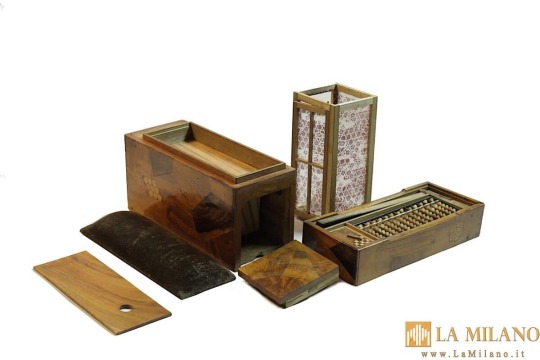
Bologna: I Musei Civici d'Arte Antica acquisiscono per donazione un pregevole nucleo collezionistico di oggetti e opere d'arte orientali di Norman Jones. Il Settore Musei Civici Bologna Musei ha acquisito un pregevole nucleo collezionistico costituito da 146 oggetti e opere d'arte orientali – giapponesi, cinesi e indiani - appartenuti a Norman Jones (1903-1985), grazie al generoso atto di donazione voluto dalla figlia Ruth Jones, docente inglese residente a Bologna. A seguito dell'accettazione autorizzata con delibera della Giunta del Comune di Bologna, questo consistente patrimonio artistico, stimato in un valore complessivo di euro 64.116, viene incluso nelle raccolte permanenti del Settore Musei Civici Bologna, andando ad arricchire con nuovi pezzi di significativo interesse le analoghe raccolte legate all'arte orientale già presenti presso il Museo Civico Medievale ed il Museo del Tessuto e della Tappezzeria "Vittorio Zironi". In particolare, è il Museo Civico Medievale la sede individuata per la futura conservazione delle opere che, compatibilmente con la programmazione dell'istituzione museale stessa, saranno esposte in modo da consentirne la più ampia fruibilità da parte del pubblico e degli studiosi. L'eclettica raccolta di Norman Jones comprende tessuti, sculture, miniature, stampe, disegni e acquerelli di diversa provenienza. Insieme ad un piccolo nucleo di miniature indiane del XVIII-XIX secolo, spiccano soprattutto la serie di oggetti cinesi risalenti alla dinastia Qing (tessuti ricamati, mandarin squares, sculture, acquerelli) e quella di opere giapponesi (secoli XVIII-XX). Quest'ultima annovera alcuni pezzi di notevole valore artistico come documentano la serie di netsuke in ambra e legno, tra cui una siglata, raffigurante la morte che assale un lupo. La parte più consistente della donazione è costituita da 68 esemplari di stampe giapponesi ukiyo-e dei secoli XVIII e XIX, realizzate da alcuni dei più noti e celebrati artisti del periodo Edo. Sono infatti presenti, tra le altre, opere di Kitagawa Utamaro (1753-1806), Katsushika Hokusai (1760-1849), Utagawa Toyokuni (1769-1825), UtagawaToyohiro (1773-1828), Utagawa Hiroshige (1797-1858), Kikukawa Eizan (1787-1867) e Utagawa Kuiyoshi (1798-1861). Tra gli oggetti giapponesi più singolari si segnala il bel cuscino per geisha con cassetti e oggetti quotidiani risalente alla fine del periodo Edo (seconda metà del XIX secolo). Sottolinea Eva Degl'Innocenti, direttrice Settore Musei Civici Bologna: "La donazione di questa pregevole collezione, dovuta alla sensibile generosità di Ruth Jones, incrementa il patrimonio culturale del Settore Musei Civici Bologna attraverso il Museo Civico Medievale in sono conservati i 146 oggetti e opere d'arte donati che saranno studiati (anche grazie alla collaborazione del Centro Studi d’Arte Estremo-Orientale), catalogati, esposti e valorizzati per consentirne la più ampia fruizione a studiosi e visitatori e la condivisione con tutte le tipologie di pubblico". "Dopo la donazione della ricca e preziosa collezione di vetri antichi da parte di Liana Cappagli Serretti nel 2020 - commenta Massimo Medica, direttore Musei Civici d'Arte Antica | Settore Musei Civici Bologna - i Musei Civici d'Arte Antica, a distanza di pochi anni vedono nuovamente incrementare il proprio patrimonio tramite la nuova e importante donazione di Ruth Jones - un'inglese da anni trapiantata a Bologna - comprendente una raccolta assai significativa di oggetti e opere d'arte orientale, formata dal padre Norman Jones. Un gesto sicuramente di grande rilievo, che mette in evidenza l'apprezzamento e la fiducia dimostrati nei confronti dei musei civici bolognesi, da tempo impegnati a valorizzare, anche attraverso la collaborazione con il Centro Studi d'Arte Estremo-Orientale, le proprie collezioni extra-europee ed in particolari orientali". Norman Jones nacque in Africa da famiglia inglese nel 1903. Trascorse la prima giovinezza a Londra e sull'Isola di Wight, in seguito completò gli studi al St. Catherine's College di Cambridge con la Laurea in Storia. Trascorse quasi tutta la sua vita lavorativa come insegnante di scuola elementare a Harrogate, nella contea dello Yorkshire, dove morì nel 1985. Durante gli anni universitari sviluppò la passione per il collezionismo di esotici oggetti orientali, libri e fotografie, diventando assiduo frequentatore di negozi di antiquariato a Londra, Cambridge, York e Harrogate. La collezione di arte orientale Norman Jones sarà oggetto di studio dettagliato dello stato di conservazione, ricerca storico-artistica e catalogazione, attività preliminari all'organizzazione di un progetto espositivo di presentazione ufficiale previsto nel 2024.... #notizie #news #breakingnews #cronaca #politica #eventi #sport #moda Read the full article
0 notes
Text
I miti del Giappone a Torino
Dal 23 febbraio al 25 giugno 2023, la Società Promotrice delle Belle Arti di Torino ospita la mostra Utamaro, Hokusai, Hiroshige. Geishe, samurai e i miti del Giappone. L’esposizione, curata da Francesco Paolo Campione, direttore del MUSEC di Lugano, prodotta da Skira, presenta l’universo giapponese attraverso un percorso tematico suddiviso in nove sezioni, con oltre 300 capolavori e alcune opere…

View On WordPress
0 notes
Photo

UTAMARO, HOKUSAI E HIROSHIGE Geishe, Samurai e la civiltà del piacere. Gli artisti giapponesi più noti le cui opere sono l’espressione estetica più alta di quella che potrebbe essere definita una civiltà del piacere
1 note
·
View note
Text
Elizabeth Keith (30 April 1887 – 1956) was a Scottish artist and writer. She was a print-maker and watercolorist whose works were significantly influenced by her travels to Japan, China, Korea and the Philippines.
Keith was born in Aberdeenshire, Scotland. She was a cousin to Sir Arthur Keith. It is uncertain, however, if Keith was born in 1887 or 1888.
Keith's work consists of prints depicting Asian life and culture, a fascination she acquired when she travelled to Tokyo at the age of 28 and remained there for nine years. In her first year in Japan, she had a small exhibition with caricatures of foreign residents in Tokyo, which she published as a book benefiting the Red Cross entitled Grin and Bear It. From a trip to Korea she brought some watercolors back and exhibited them in Tokyo--she claimed it was "the first exhibition of Korean subjects ever held there." Watanabe Shōzaburō, the Shin-hanga publisher saw her exhibition and convinced Keith to transform one into a woodblock print - a view of the East Gate in Seoul.
Keith would continue her travels throughout Asia, visiting China, Korea, and the Philippines, gathering more subjects for her artwork. She learned the methods of traditional Japanese woodblock printing, emulating the work of Katsushika Hokusai, Ando Hiroshige, and Kitagawa Utamaro. Keith’s work gained popularity not only in Japan, but also in London and New York. Landscapes, people in traditional and common dress, and cultural rituals were central to her imagery. She also created portrait prints in the vein of a Chinese painted portrait tradition called xingle tu or "pleasure portraits."
In 1924 Keith returned to Britain where she started to learn colour etching techniques, and in 1925 began to print her own works, using an initial seal "in the oriental manner" to sign them. In 1928, she published an illustrated travel diary of her time in Asia called Eastern Windows. Keith was back in Asia and Japan from 1929 to 1932, then again in 1934--in between these visits she was elected a Fellow of the Royal Society of Arts in London.
In 1936 and 1937 Keith had exhibitions in America, supported by California-based collector of Asian art Grace Nicholson, as well as an exhibition at the Beaux Arts Gallery in London which was visited by Queen Elizabeth the Queen Mother. During World War II, Keith raised money to assist Chinese women affected by Japan's military violence, though she apparently "retained warm feelings for her many Japanese friends." In 1946 she and her sister Elspet published a book titled Old Korea: The Land of the Morning Calm, which included criticism of Japan's colonisation of Korea before and during the war and was dedicated to General Douglas MacArthur, Lord Louis Mountbatten, and Admiral Chester Nimitz.
Keith died in London in 1956 after a prolonged illness.

Elizabeth Keith "Blue and White"
81 notes
·
View notes
Text
Torino, Società Promotrice delle Belle Arti: "Utamaro, Hokusai, Hiroshige. Geishe, samurai e la civiltà del piacere"
Kobayashi Kiyochika, Bellezza dell’era Kyōhō dalla serie “Motivi floreali”, stampa xilografica, 1896 Per quattro mesi, Torino si vestirà delle luci, dei colori, delle suggestioni del Sol Levante Il Giappone protagonista a Torino Dal 23 febbraio al 25 giugno 2023 alla SOCIETÀ PROMOTRICE DELLE BELLE ARTI SKIRA presenta: Utamaro, Hokusai, Hiroshige. Geishe, samurai e la civiltà del piacere Il…

View On WordPress
0 notes